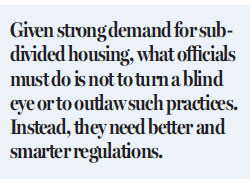Pragmatic approach needed to meet housing demand
Updated: 2017-08-18 06:33
(HK Edition)
|
|||||||||
Subdivided apartments with illegal structural alterations and fire hazards have often been described as "accidents waiting to happen". Well, it has happened, and three people have died. The latest tragedy is actually not the first and is unlikely to be the last.
On the evening of Aug 12, a deadly fire broke out on a high floor of a 45-year-old industrial building in Kwai Chung where the space was illegally partitioned into more than a dozen units for offices, workshops, storage and residences. The old building had no automatic sprinklers, which were not required at the time of its construction. The victims hid in a washroom where they appeared to have died from suffocation.

The deaths have refocused attention on a social problem that just won't go away and has increased pressure on the new administration of Carrie Lam Cheng Yuet-ngor to find a lasting solution. This housing problem has become a political hot-potato putting the credibility of the government on the line. Lam at least recognizes that the problem is pressing and that stakeholders, especially officials, need "to think outside the box" for solutions. She is absolutely right about this.
About 200,000 people comprising 85,500-plus households live in subdivided apartments across the city. About 65 percent of these units range in size between 75 square feet and 140 sq ft. Most of these partitioned units are found in old tenement buildings, usually located in Hong Kong's poorest districts.
Clearly, a complex problem requires a multi-pronged approach, one that must offer quick relief for people and families living in the worst kind of partitioned housing and longer-term solutions to resolve a problem that has become a bane in a rich city like ours. There is a strong demand for subdivided apartments because prices and rental costs of regular apartments make it all but impossible for grassroots families to afford them. The scandal is that, square foot for square foot, rent for a subdivided apartment is often more than for a luxury one.
Ideally the previous government's target of having 480,000 new homes by the middle of the next decade - of which 200,000 will be public housing units - should address the problem eventually. But housing officials have already warned that 1,000 hectares of land have yet to be found to meet the full quota. Meanwhile, the long queue for public housing has moved the average waiting time back to its historic high of 4.6 years. Some families wait even longer because they reject initial offers, usually because the location is out of the way.
The Society for Community Organization has launched its own partitioned units, which charge rents at cost for low-income families. It is asking the government and other welfare NGOs to operate more subdivided apartments to ensure they are at least safe and clean. It goes without saying that public housing is the only long-term solution that will offer a permanent home, but this takes time.
The Hong Kong Institute of Surveyors has voluntarily developed structural and fire-safety standards for buildings with subdivided units. Such welfare groups and the government recognize these are only temporary solutions, but still worth pursuing.
Given strong demand for subdivided housing, what officials must do is not to turn a blind eye or to outlaw such practices. Instead, they need better and smarter regulations. Legislating and enforcing standards such as those proposed by the institute offer a way forward. The priority is to ensure safety and hygiene. If owners of industrial buildings are willing to meet such standards, apply for conversion to residential purposes and promise to keep rents below a pre-set level, a substantial discount to land conversion premiums may be offered as an incentive.
However, enforcement and compliance will always be a problem. According to a report by the Public Accounts Committee of the Legislative Council in 2015, the number of reports of unauthorized building works jumped to an average 42,124 a year between 2011 and 2014, from 23,947 a year between 2001 and 2010. There were more than 68,000 outstanding removal orders at the end of 2014. Of these, 20 percent had not been dealt with for up to 10 years and 753 cases were untouched for up to 30 years.
So it's not just a matter of stepping up enforcement and inspection. To compel compliance, new laws should be considered to make landlords criminally liable to injuries and loss of life to tenants. Threatening unscrupulous property owners with significant jail time is the only effective deterrent.
The author is a veteran commentator and journalist from Hong Kong.
(HK Edition 08/18/2017 page11)